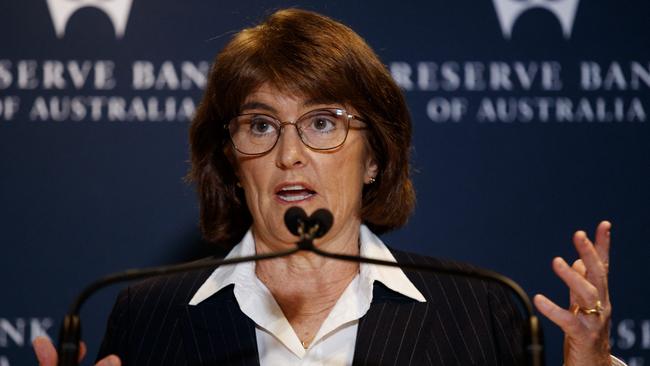RBA board open to further interest rate cuts despite the global ructions of Trump’s tariffs
The Reserve Bank may end up easing too much from here, but it will be justifiable as the erratic trade policy of the Trump administration continues to be a threat to the outlook.

Business
Don't miss out on the headlines from Business. Followed categories will be added to My News.
If the Reserve Bank ends up easing too much from here it will be completely justifiable, as the erratic trade policy of the Trump administration remains a serious threat to the global economic outlook.
Tuesday’s announcement of a 25 basis-point cut in the official cash rate target to 3.85 per cent was widely expected. However, a dovish shift in communication from the board was a mild surprise, sparking additional gains in the stockmarket and falls in bond yields and the dollar.
While noting that recent announcements on tariffs had resulted in a rebound in financial markets, the RBA board said there was “still considerable uncertainty about the final scope of the tariffs” and they were “expected to have an adverse effect on global economic activity, particularly if households and firms delay expenditure pending greater clarity on the outlook”.
“This has also contributed to a weaker outlook for growth, employment and inflation”.
The net result was the addition of roughly one interest rate cut to market pricing, to now imply three or four more quarter-percentage-point cuts by the time of the May 2026 meeting.
That would take the cash rate target close to 3 per cent, versus the post-Covid peak of 4.35 per cent.
It’s a touch below the RBA’s latest assumption of a 3.2 per cent “terminal rate” which, according to the bank, is now consistent with trimmed mean inflation of 2.6 per cent on-year – in other words, “around the midpoint” of the 2-3 per cent target band.
However, in her press conference, RBA governor Michele Bullock unusually didn’t push back on market pricing of further rate cuts. In fact, she rejected the notion of any “disconnect” between market pricing on the cash rate outlook and the RBA’s expectation.
“We’ve had April 2 [tariffs] happen, we’ve had massive volatility in financial markets, massive uncertainty not only about where the eventual policies in respect to tariffs turn out, but also, once we do have certainty on that, what impact that might have,” she said.
When it was put to her that this was a “very dovish cut” in terms of the board’s communication, Ms Bullock clearly didn’t want to smack down the idea that a string of further rate cuts was likely.

“I think it is different than it was in February,” she said.
“Now does that mean that we are headed into a long series of interest rate cuts? I don’t know at this point, and that’s why I think the cautious 25 basis-point cut with a recognition that if we need to move quickly, we can. We’ve got space.
“I think that’s the most appropriate way to think about it.”
After saying since February 2024 that “sustainably returning inflation to target is the priority”, the board’s post-meeting decision statement shifted to saying that inflation was “expected to remain around target” and that “maintaining low and stable inflation is the priority”.
It was not so long ago that Ms Bullock was saying that getting underlying inflation back inside the target band wasn’t enough for the RBA and that it actually wanted to hit the midpoint.
But now with trimmed mean inflation hitting 2.9 per cent in the March quarter and forecast to hit 2.6 per cent for the next two years – albeit with a very wide band of uncertainty spanning from under 1 per cent to over 4 per cent – the RBA is effectively declaring the inflation battle is won and the coveted “soft landing” has been achieved.
“Inflation is in the target band and upside risks appear to have diminished as international developments are expected to weigh on the economy,” the board said.
“With inflation expected to remain around target, the board therefore judged that an easing in monetary policy at this meeting was appropriate.”
It also considered a “severe downside scenario” – where an escalation of the trade conflict leads to a protracted trade war – and said monetary policy was “well placed to respond decisively to international developments if they were to have material implications for activity and inflation in Australia”.
In her media conference, Ms Bullock said: “What we’ve managed to achieve here … so far, we have managed to get inflation back at the same time as keeping the employment market on a relatively good footing. So I think that’s so far so good.”
Despite pushing back hard on the idea of further rate cuts in February, she said the board would have cut rates in May, regardless of whether US President Donald Trump increased tariffs.
She said businesses were finding it difficult to pass on cost increases, and the fact that inflation fell in line with its forecasts gave the board enough confidence to cut rates.
Adding to the dovish tone of the press conference, Ms Bullock said the board considered a 50 basis-point cut in the cash rate target, but decided that 25 bps “was the right thing for now”.
“There was a bit of a discussion about hold, and that was sort of put aside pretty quickly and the discussion then was about a cut and how big,” she said. “And there was a discussion about 50 and 25. The board was of the view that 25 was the right number.
“The way I would think about it, or describe it, is that, if you put the international things to the side for one moment and just ask the question, if we were just looking at where the domestic economy was at the moment, would we be looking at lowering rates or not?
“And as I said earlier, with inflation in the band and also unemployment doing pretty well, we think there is a bit of scope to lower interest rates.
“And then if you add the international uncertainty, that sort of gives you a little bit of confidence.
“So I think we said in the statement that the risks have actually balanced up a bit with a bit more on the downside coming into play now.
“So yes, there was a discussion of that, but on balance, I think that the board was of the view that, well, I know the board was of the view, that 25 basis points was the right thing for now.
“It doesn’t rule out that we might need to take action in the future … but for now, we felt that was the right number.”
Originally published as RBA board open to further interest rate cuts despite the global ructions of Trump’s tariffs



